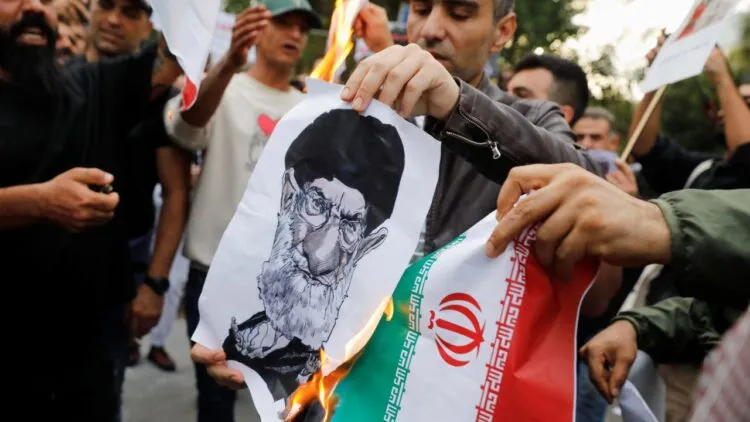Iran has experienced protests for a third week in a row, which worries the mullahs’ leadership. According to the Washington Post, the protests were distinguished by provocative banners that denounced the Iranian government’s limitations on all facets of social life in the nation.
According to Amnesty International and The Washington Post, government security forces used deadly force in their response, killing at least 52 people, including women and children.
The current demonstrations started in response to the passing of Mahsa Amini, a 22-year-old Iranian woman who was arrested by the “moral police” and put into a coma before passing away.
Ali Khamenei, the supreme leader of Iran, asserted on Monday that foreign governments were behind the turmoil, that demonstrators were to fault for the bloodshed, and that Iranians calling for justice and freedom were “thugs, robbers, and blackmailers.”
“Khamenei offered the security forces his “full support,” expressing concern that another round of repression might be on the way.
The Washington Post consulted with human rights advocates, interacted with protestors, interviewed protesters, and looked over data gathered by internet monitoring groups in order to assess the nature of the government’s crackdown on protesters.
The newspaper geolocated footage of demonstrations in at least 22 locations, ranging from Rasht on the Caspian coast to Bandar Abbas, a port city on the Persian Gulf, and from the Kurdistan area, where the demonstrations first started.
The three primary methods the administration employed to put an end to the protests were the apparent use of live bullets, the arrests, and the slowing of internet access.
Protesters in Marivan, Palu, and Tehran who were questioned by the newspaper verified the findings.
For fear of retaliation from the security forces, everyone spoke on the condition of anonymity.
A demonstrator in Marivan, a 50,000-person city in the Kurdish west, called the situation on Saturday “martial law.” “Over 1,000 security personnel, I believe, were present. Every square, intersection, and main street was full of them.
The newspaper tracked out the video, which depicts security personnel firing on protestors, in seven towns.
“It is very likely that security forces have been using live ammunition against protesters during the events of the recent days and weeks,” said Jenzen Jones, Director of Arms Research Services, after reviewing the videos. However, it was impossible to confirm the type of shots used from the videos alone. The Washington Post commissioned the video.
According to Tasfer, an anti-government Iranian watchdog group, security agents have been firing randomly at demonstrators ever since the demonstrations began.
Videos taken on September 17 in the Kurdish city of Saqqaz, where Amini was born, seem to support Tasvir’s assertion.
Pictures from the day of Amini’s burial show demonstrators strolling through the city. Officers on motorbikes fire in their direction, soon scattering the mob.
A group is seen bringing an unconscious young man covered in blood to a medical facility in a video clip shot on neighbouring side streets.
After reviewing films from the Washington Post, analysts at Jane’s, a defence intelligence supplier, concluded that two of the videos most likely depicted the firing of live fire.
Police in the northern city of Rasht opened fire with their handguns at a throng that was fleeing in a video that was posted on September 20.
An AK-47 assault rifle is calmly pointed and fired by a military uniformed guy in a video clip that was made public on September 23 in Tehran.
Security forces were instructed to “forcefully confront demonstrators” in a leaked letter from the Iranian military headquarters that was obtained by Amnesty International and seen by The Washington Post on September 21.
Two days later, the commander of the armed forces for the province of Mazandaran released another memo that went even farther, ordering the security forces to “confront mercilessly rioters and counter-revolutionaries.”
In the western cities of Marivan and Palu, protestors who were interviewed by the newspaper claimed to have witnessed security personnel shooting at demonstrators.
When asked about the crackdown on October 1st, a demonstrator in Marivan stated, “The security forces shot directly at civilians in Daray Square.”
“They had no desire to make an arrest or calm the scene. All they wanted to do was shoot.
Iranian Kurdish woman Mahsa Amini passed away three days after being detained in Tehran by the morality police under the guise of upholding the Islamic dress code.
Her passing provoked a surge of demonstrations in Iran as well as marches in support of Iranian women everywhere. Despite a security response during which hundreds of people were detained and several were killed, the protests went on.
Iran Human Rights Organization, based in Oslo, claims that since September 16 at least 92 people have died in Iran (IHR).
The Fars news agency reported the deaths of “approximately 60 people,” while Amnesty International confirmed the deaths of 53 people. Twelve members of the security forces were also reportedly slain.
How did the mullahs’ regime put down the rebellion in Iran?

